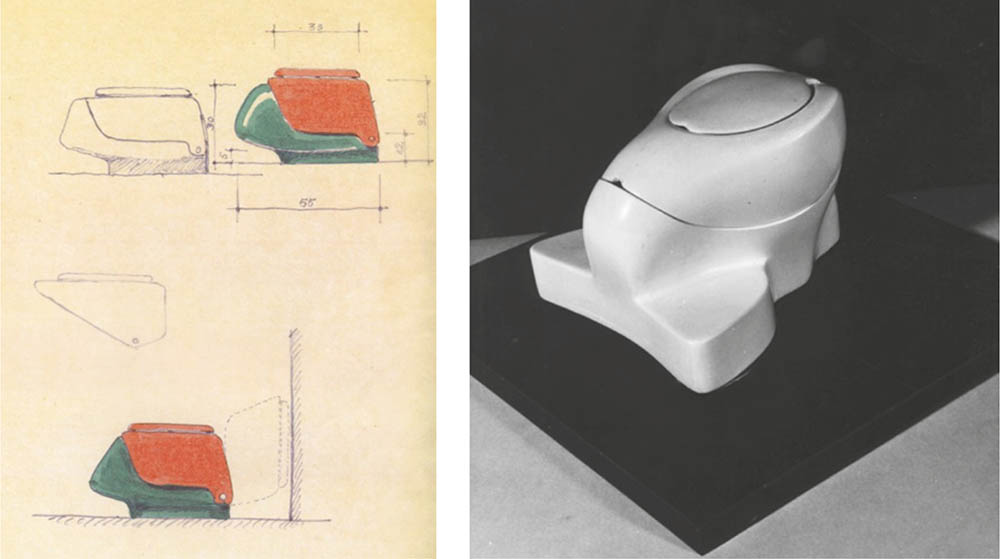Body, Space, Society, Ideals in the Modernist Turkish Context
Downloads
DOI:
https://doi.org/10.52200/docomomo.73.06Keywords:
hygiene, crisis, modern interiors, bathrooms, modern Turkish interiors, design competitionsAbstract
The focus of this paper is the significance of the modern bathroom in Turkey, its meaning in the modernization of interiors, in terms of hygiene as a precaution for crises, as well as sanitary ware, and Turkish company VitrA’s role in continuously emphasizing the modern bathroom and challenging behavioral habits through design competitions, from the 1940s onwards.
Among one of the most important spaces of hygiene, the bathroom was instrumental in bringing Western habits into the modern Turkish house. Hygiene was a matter of modern national identity emphasized in the Ottoman Empire at the turn of the century, even before the foundation of the Turkish Republic in 1923.
The Western ideals of comfort and hygiene, bodily practices, and lavatory fixtures all contributed to the understanding of the modernization process of Turkish interiors. Moreover, a bathroom that combined the Western and today’s internationally accepted alla franga lavatory, a sink and a bath, thus combining these activities became a household application and a reflection of modern life. In the 1950s and 1960s, as the average urban Turkish family life moved to apartments that often housed governmental civil servants, the modern bathroom became a standard household space. Meanwhile, the alla turca lavatory, a lavatory on which one has to crouch, and that is still used in certain parts of Turkey and Asia, represented the uncivilized and unhygienic.
With the modernization of the domestic interior, a transformation of wet allocation spaces took place, leading to the questioning of the domestic and public. Moreover, new materials and bathroom equipment were introduced, and bathroom equipment competitions were established, leading to inventions that synthesized habits of the East and the West, reaching a new hygienic standard regarding relevant potential crises. Both the company history of VitrA Eczacıbaşı and the competing designs are showcased in the paper, aiming to support an understanding of social and spatial change in the modern Turkish domestic interior that has redefined identity with proactive lessons for the future.
How to Cite
Published
Issue
Section
License
Copyright (c) 2025 Deniz Hasirci

This work is licensed under a Creative Commons Attribution 4.0 International License.
Plaudit
References
Anon, (1970). Eczacıbaşı VitrA OR-AN Toplu Konut Kuruluşları Seramik Konut Gereçleri Dizayn Yarışması Sonuçlandı. Mimarlık, 82, pp. 13-20. Available at: http://dergi.mo.org.tr/dergiler/4/401/5867.pdf (Accessed: 22 Sept 2023).
ASATEKIN, M. (1996). İdeal banyo üzerine kısa bir not. [A few notes on the ideal bathroom]. Arredamento, 92-93.
ASATEKIN, M. (2021). Or-AN Eczacıbaşı Yarışmaları Hakkında [On OR-AN Eczacıbaşı Competitions], Online communications by Deniz Hasirci, archived by DATUMM: Documenting and Archiving Turkish Modern Furniture, https://datumm.org.
ASLANOĞLU, I. (2003). The International Style in Turkey, A Sign of Contemporaneity for a New Republic. Unpublished lecture notes, Ankara: Middle East Technical University.
AYTAÇ, A., & Öğüt Ş.T. (2015). Türkiye’de Modern Banyonun Değişimi: Dergi Reklamları Üzerinden Bir Değerlendirme [The Change of Modern Bathroom in Turkey: An Evaluation through Magazine Advertisements], Journal of Yasar University, 10(37), 6449 - 6464. DOI: https://doi.org/10.19168/jyu.62919
BEKTAŞ, C. (1996). Türk Evi. [Turkish Home]. Istanbul: Yapı Kredi Yayınları.
BOZDOĞAN, S. (2001). Modernism and Nation Building: Turkish Architectural Culture in the Early Republic (Studies in Modernity and National Identity). University of Washington Press: Seattle and London.
CENGIZKAN, A. (2002). Yabancılaşma nesnesi olarak banyo: modernizm, tüketim toplumu ve banyo kültürü. Modernin saati. [The bathroom as an object of alienation: modernism, consumer society and bathroom culture. The hour of the modern]. İstanbul: Mimarlar Derneği.
Cumhuriyet (1970). ‘Türkiye 1970 Seramik Konut Gereçleri Yarışması’. [Turkey 1970 Ceramics Domestic Equipment Competition]. (1970). 5 April [Online]. Available at: https://egazete.cumhuriyet.com.tr/oku/192/1970-04-05/ (Accessed: October 22, 2023).
Eczacıbaşı Group (2021). [Group Milestones]. https://www.eczacıbaşı.com.tr/en/eczacıbaşı-group/group-milestones.
ERSIN, S. (2017). Interview by Zeynep Tuna Ultav and Deniz Hasirci, DATUMM: Documenting and Archiving Turkish Modern Furniture, https://datumm.org.
GEÇILI, D. (2019) Sea Baths Started Construct in Coasts of Istanbul and the Surrounding Area in the Ottoman State. Journal of Ottoman Civilization Studies, 5(9), 150-164.
GÜREL, M. O. (2008). Bathroom as a modern space. The Journal of Architecture, 13(3), 215-233. DOI: https://doi.org/10.1080/13602360802214943
GÜVEN, G. G., & Karakuş, G. 2016. Türkiye Tasarım Kronolojisi: Seramik. [Turkey Design Chronology: Ceramics]. İstanbul: İKSV.
HASIRCI, D., Tuna Ultav, Z., (2019). Mid-Century Modern Furniture Representing Modern Ideals in the Grand National Assembly of Turkey. Journal of Interior Design 45(2), 11-33. DOI: https://doi.org/10.1111/joid.12160
HASIRCI, D., Tuna Ultav, Z., & Örnekoğlu Selçuk, M. (2022). Sözlü Tarih Yöntemiyle Türkiye’de Mobilya ve İçmimarlık Tarihini Okumak: Sadun Ersin. [Reading the History of Furniture Design and Interior. Architecture in Turkey through Oral History Method: Sadun Ersin]. Izmir: Izmir University of Economics Publishing.
LEFEBVRE, H. (2014). Critique of Everyday Life: The One-Volume Edition. New York: Verso Books.
OR-AN Yapı Endüstri Dergisi, Construction Industry Journal, 2023. DATUMM Archive, datumm.org, 2023.
ÖZAKTAŞ, A., Arsev, S. (1943). Yenice Hamamı, Eskişehir. [Yenice Hammam in Eskişehir-Turkey]. ARKİTEKT, No: 1943-01-02: 22-26.
TUNA ULTAV, Z., Hasırcı, D., Borvalı, S., & Atmaca, H. (2015). Dökümantasyon ve Arşivleme. Türkiye’de Modern Mobilya [Documenting and Archiving - Turkish Modern Furniture]. (datumm.org). İzmir: İzmir University of Economics.
ULUEREN, Ş.D. (2005). From yesterday to today with Doğan Hasol, Seramik Türkiye. Journal of Turkish Ceramics Federation, 8: 92-97.
VitrA (2023). Dünden Bugüne VitrA [Online]. Available at: https://www.VitrA.com.tr/hakkimizda/dunden-bugune-VitrA/. (Accessed: October 2, 2023).
WISHNITZER, A. (2015). Reading clocks, alla Turca: time and society in the late Ottoman Empire. Chicago and London: The University of Chicago Press. DOI: https://doi.org/10.7208/chicago/9780226257860.001.0001





